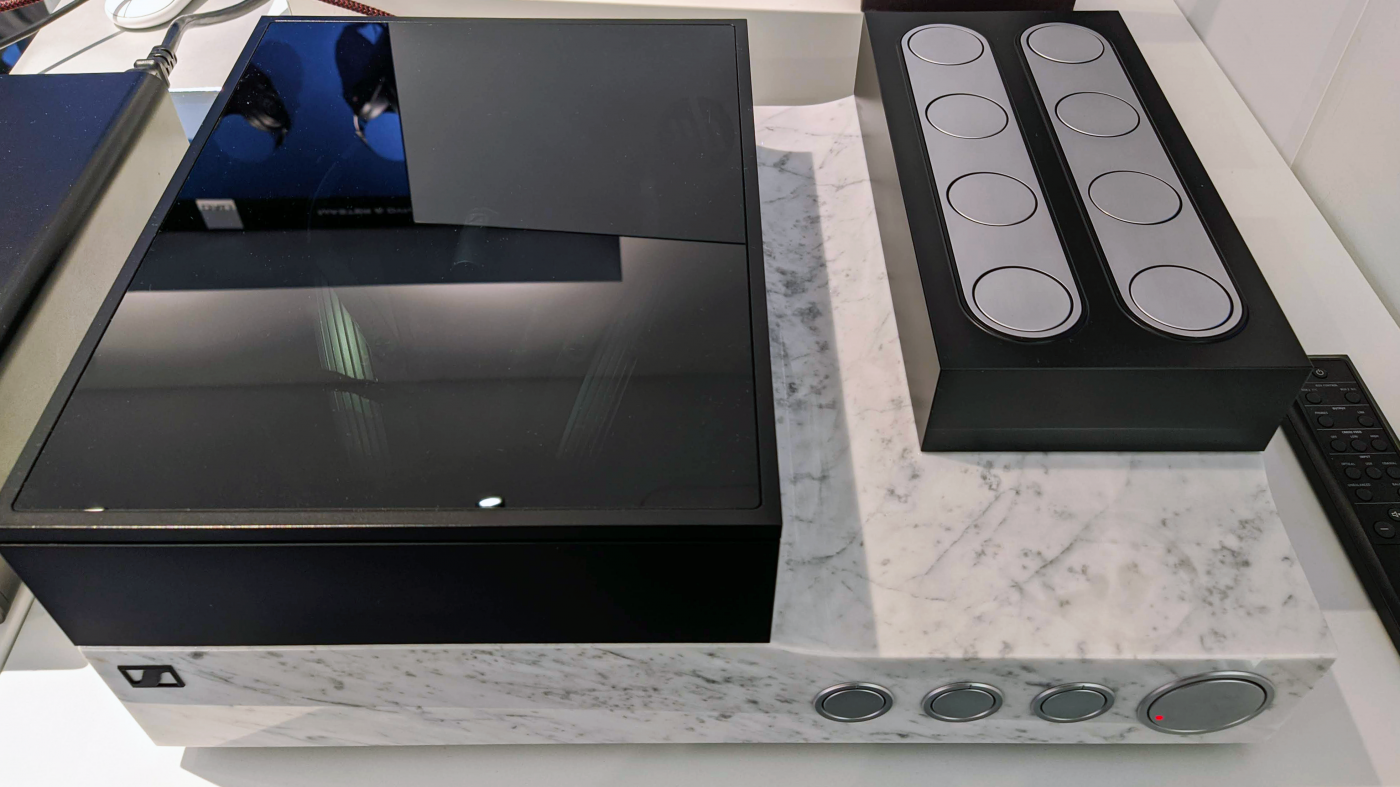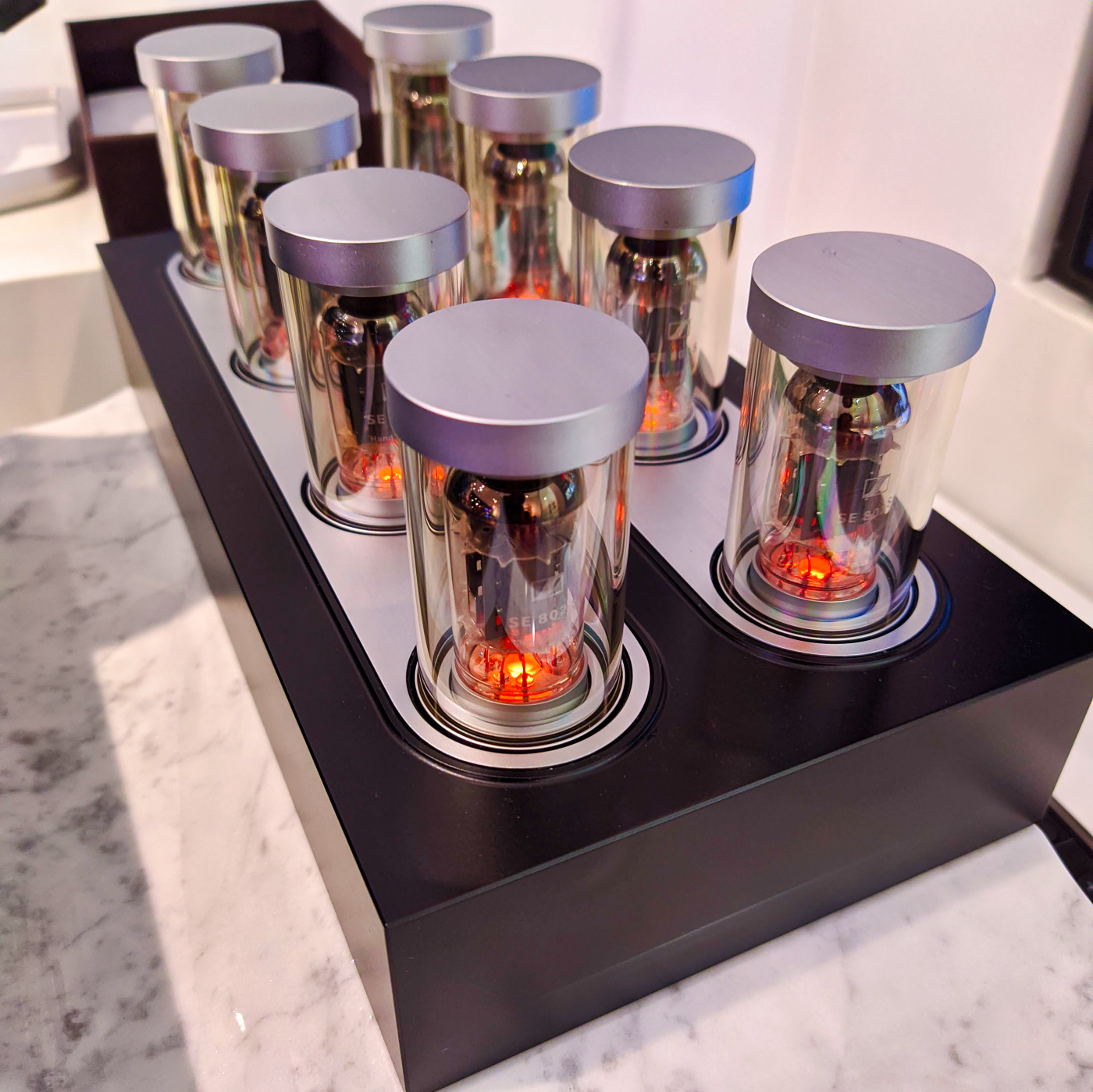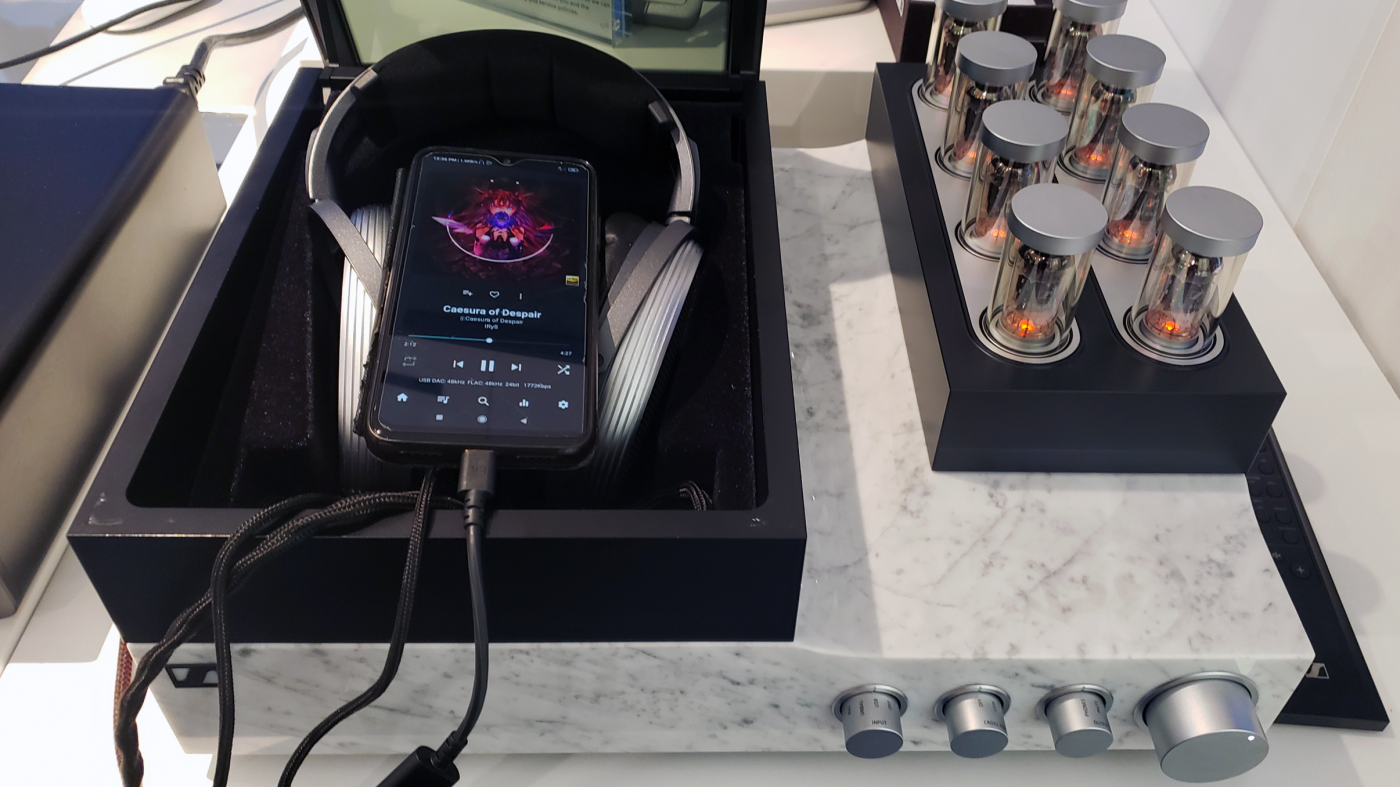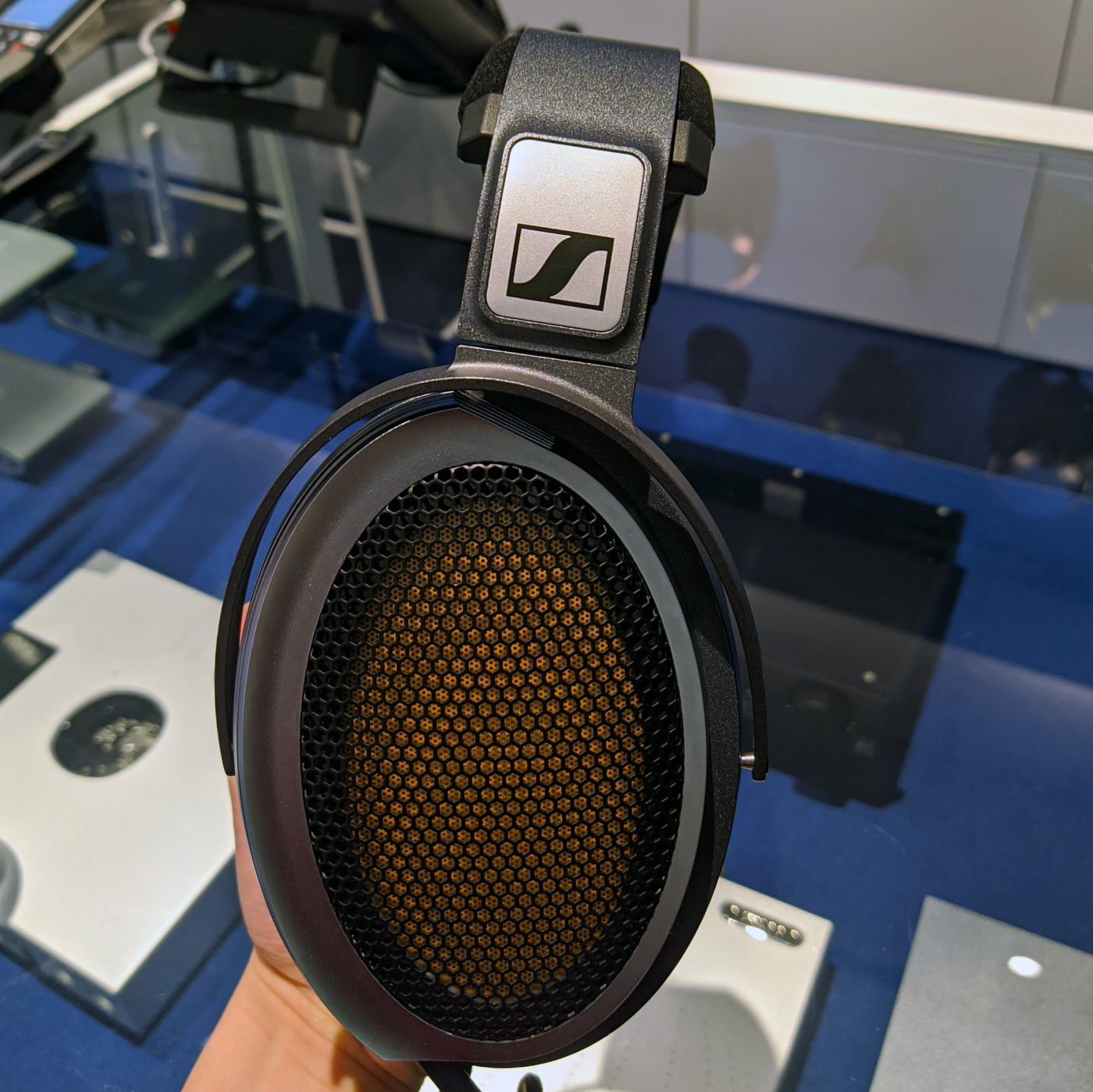Sennheiser HE-1 Impressions - How does a $50,000 headphone sound?

Introduction
The Sennheiser HE-1 is the greatest headphone in the world. Sennheiser’s magnum opus. A transcendental work of engineering art meticulously crafted to command perfect audio reproduction through electrostatic diaphragms harmoniously fed pure power by ultra-low distortion tube and transistor amplifiers resting atop a luxurious throne of majestically sculpted Carrara marble and glass. Or so the story goes.
For a bit of context, the Sennheiser HE-1 is actually the latest iteration of Sennheiser’s flagship Orpheus line. Previously came the HE-90 and its little brother, the HE-60 (baby Orpheus), released in the 1990s. All of them are based on electrostatic designs. Though the exact prices of the older models are hard to pin down given inflation, as far as I can tell they cost approximately $12,900 and $1,690 respectively back in 1995. The HE-1 leapfrogs both at an eye-watering starting price of $50,000. The majority of this cost seems to stem from its paired amplifier system. Presumably, the increased complexity of a marble encased amp with motorized tubes and dials adds to the jaw-dropping cost.
The real question I care about is how it sounds. Thankfully, I had a very generous two hours of uninterrupted head time with the HE-1 at Bay Bloor Radio where Sennheiser had unexpectedly left a demo unit for an unknown length of time. The listening environment was far from perfect given the noisy store environment and the HE-1’s open-back nature, but of course I’m more than grateful for the opportunity to hear it. So let’s get started. What sort of experience does the most expensive headphone in the world afford you?
First-Hand Experience
To be honest, my first look at the HE-1 was unceremonious. Placed in the corner of the shop on an open listening counter besides other headphones and IEMs, it was easy to glance over it without knowing if you weren’t there for the explicit purpose of listening. The Carrara marble base is elegant but understated. In its off state, you could hardly tell it housed a headphone and amplifier system.
But turn it on however and that’s where the magic happens. The headphone case automatically opens up to reveal the HE-1 itself while the dials and tubes gradually emerged from their slumber. As the tubes took on their characteristic warm glow and I fiddled with the dials, I realized how the slow burn of a power on sequence here intentionally builds upon the feelings of anticipation and excitement as it guides its beholder into the next stage: listening.
Holding the HE-1 in my hand, it’s light and well-balanced. It feels substantial without an overbearing need for delicate handling like I had initially expected. To an extent, it betrays its lofty price tag. The HE-1 feels like a very much like your favorite headphone, one that’s comfortable and inviting rather than something to be placed on a marble pedestal and enjoyed only your eyes.
Speaking of comfort, the HE-1 is the most comfortable headphone I’ve ever worn. It has very large oval-shaped cups similar to the high end HiFiMan models that completely envelops and cradles the sides of my head. Its headband is an oversized piece of soft foam that effortlessly distributes the weight of the HE-1 on the top of my head while the pads are a seamless mix of microfibre velour and leather. Both the pad depth and clamp force are perfect. My ears have a healthy distance from the drivers and even over my glasses, the HE-1 forms a superb seal. It’s been clearly designed with comfort as a top priority in mind to allow for nothing in the way between you and the HE-1’s auditory experience.

Sound
Let me set the tone for this section. I didn’t cry. I didn’t fall to my knees. Nor did I see the heavens split open in an angelic choir. The Sennheiser HE-1 is still a headphone. An unfortunate truism in audio is that re-creating that first moment of enlightenment is next to impossible. And with all that said, the HE-1 is the best headphone I’ve ever heard. Though it didn’t immediately blow me away, the HE-1 presented layers of complexity and nuance that I was challenged to unravel.
The first thing that jumped to mind as I started listening to the HE-1 was its phenomenal tuning. It has practically perfect tuning in the bass. Its mid-range is near perfect save for a slight 1 – 2 kHz cut if you’re not a fan of that sort of thing. Treble, however, is where one might hesitate. I would consider the HE-1 to be a bright headphone that doesn’t hold anything back. Altogether, the tuning of the HE-1 is highly engaging while maintaining a pleasant reference-like quality to it.
The second thing that stood out to me was the HE-1’s staging. Surprisingly, the HE-1 did not have a massive soundstage like you would expect from something like the higher end HiFiMan offerings or Sennheiser’s own HD800(S). Nor it doesn’t sound extremely open either. There’s an unexpected level of intimacy on the HE-1. This isn’t to say that the soundstage on the HE-1 is small though. There’s a respectable size to its soundstage with an equal distribution between width, depth, and height. While the HE-1 has superb imaging, I do think it could use a little bit more spacing in its layering. The limited scope of its stage is a reminder that the HE-1 is ultimately still a headphone, one constrained by the limits of its form factor.
Tuning
Bass
Tuning wise, the bass of the HE-1 is what impressed me the most. In truth, I was expecting a totally flat bass with no elevation at all. The HE-1 surprised me by having quite a weighty bass response. There’s a great mix of slam and impact with a natural sense of decay. It’s neither boomy nor punchy but commands both as needed. This is most clearly heard with the kick and toms. Each note is full and bodied, filled with intentionality. Similarly, the bowing of stringed instruments like the cello or double bass are deep and rich. What I find extremely unique in the low end of the HE-1 is that there is a persistence in the bass that makes the HE-1 sound very full, like if you were in a live room where the bass presence continuously fills the room. I didn’t notice this on the HE-1 initially until I compared to another headphone immediately after and noted how empty it sounded in comparison.
At this point, I need to address an elephant in the room. The so-called “estat” sound. If you’re unaware, electrostatic headphones have a reputation for having certain timbral issues, primarily in the bass. They’re often described as a “ethereal” due to overly quick transients leading to a lack of weight and impact. Yet as you can see from my impressions of the HE-1’s bass above, nothing about the HE-1 would indicate it’s an electrostatic at all. Save perhaps for the level of resolution it brings to the table, another trait estats are infamous for. Whatever the case may be, I love what Sennheiser has done for the HE-1’s bass here. While it’s hard to say if any headphone’s bass is my absolute favourite given the multitude of competing qualities I look for, it’s very hard not to put the HE-1 at the top of my shortlist.
Mids
Like the bass, the midrange is exceptionally well done. Across the board, instruments sound effortless. Vocals take center stage but aren’t particularly forward. The HE-1’s bass elevation imparts a slight warmth to the vocal tone. As mentioned above, there is a minor 1 – 2 kHz HiFiMan-like planar dip. It’s manifests as a subtle lack of vocal body at the initial “front” of a lyrical note. For those who are highly accustomed to the signature of the HD6X0 series or familiar with the HiFiMan’s house sound, the cut here may be noticeable. That said, the warmth in the low end goes a long way to balance out this effect. Rather than a pure reference tuning, the HE-1 adds a hint of sense of pleasantness in its midrange.
Treble
The HE-1 is a bright headphone. Specifically, the upper treble can be a little intense. I think that if the HE-1 had a gentle downwards treble slope starting in its lower treble it would tame that intensity. Keep in mind that I did listen to the HE-1 for two hours straight (and could’ve gone longer) so it's not as if there are piercing treble peaks that makes it fatiguing. Likewise, vocal sibilance wasn’t an issue for me. Look past the intensity however, and you’ll see the treble brilliance that the HE-1 brings. Air and sparkle are well balanced – they don’t sound exaggerated for the sake of having an extended upper treble response. Hats and cymbals are fantastic. They’re consistently coherent even on the harshest tracks with an excellent timbre that cleanly captures everything from stick impact to decay. The HE-1 doesn’t try to hide the rawness of these instruments and gets additional points for achieving this brightness without sounding overly crisp for a more realistic tonality.

Presentation
Relatively small soundstage aside, the HE-1 elevated every song I threw at it. It makes music sound complete, for lack of a better word. It didn’t matter much if it they were poorly mix and mastered, the HE-1’s powered through it. In that sense, the HE-1 is unusually forgiving of bad recordings compared to other high-end headphones.
As expected, resolution and clarity are phenomenal. Not to the point where I’m hearing entirely new instruments or new passages hidden away somewhere in a song but for a lot of tracks, I find myself noticing a few extra notes that fleshes out a short melody or riff. More importantly however is the timbral resolution. The term “transparent” gets thrown around a lot but I really do think the HE-1 truly represents it. Let me give you two distinct examples.
1. The first is in the beginning of this song, Nornir, that features singular, percussive notes of the glockenspiel. On the HE-1, these notes sound incredibly life-like. All the nuance in each note is captured perfectly and the trailing tones of its harmonics are beautifully resolved. It sounds complete. I never realized just how much character and timbre were missing in these notes before I listened to it with the HE-1. This was the moment when I understood the definition of transparency.
2. The second is in this piano track, City Ruins . At the very end of this song are five hauntingly ethereal block chords. On the HE-1, it manages to break down these chords and individualize each of the notes within it. Though the notes are still played together, the HE-1 makes it so clear that it’s built from distinct notes that harmonize with each other rather than a solid block of notes.
The HE-1’s instrument separation, transparency, and resolution abilities complement and build upon each other to give the HE-1 the edge needed to elevate the listening experience regardless of the quality of the recording. There’s a feeling of addiction, the desire to revisit every song in my library to explore what I might have missed previously. Two hours was not enough.
Note definition is clear but not overly sharp on the HE-1. There’s a sort of natural softness or slight fuzziness in the edge of the notes. To give an analogy, it’s like if a drawn image has a bit of blending instead of hard, defined lines. This is in contrast to what I had expected given the reputation estats have and my general experience with higher end systems. Similar to what I commented on in the treble, it lends itself to a more realistic rendition of music.
Last but not least, the HE-1 has excellent dynamics. It employs a rather clever strategy where, instead of adding more energy to the top of a crescendo, the HE-1 produces a very low sound floor to create greater macrodynamic contrast. The best example of this is in that piano track I mentioned above, City Ruins. The HE-1 adds a unique sense of silence to the momentary space between piano notes that then accentuates the next passage beautifully. Other headphones don’t manage this level of transient “silence” and end up sounding flat in comparison. Of course, this doesn’t work on every track. High octane rock songs that go on without a moment of rest don’t see much benefit from the increased depth. Where it really shines is in instrumental or orchestral pieces where it can truly show off its dynamic range.

The HE-1 takes USB in as a digital source that gets passed through to its internal DAC and amp system.
Conclusion
Lofty expectations and price tag aside, the Sennheiser HE-1 is the best headphone I have heard. Or rather, I can think of no reason why the HE-1 wouldn’t claim that number one spot. Though it’s not a perfect headphone, the HE-1 is either on par or outperforms everything else I’ve heard on every metric save for soundstage. While another headphone might have one or two qualities that sets it apart, the HE-1 as a whole is unparalleled in its performance.
Of course, the final question to be answered is whether it is worth it or not. Frankly speaking, the price tag of the HE-1 is so ludicrous that it doesn’t even register to me. I’d rather have a great speaker set-up with room treatment along with the second-best headphone system in the world, whatever that may look like. And even then, I’d probably still have a healthy chunk of change left over. But I’m not Sennheiser’s target audience. Realistically speaking, the HE-1 is for people who are considering adding another Porsche to their car collection but are maybe looking around for some other luxury experience to enrich their lives. In that case, by all means. Not only does the Sennheiser HE-1 sound fantastic, it’ll look great in the listening room of any multimillion-dollar mansion.
-Fc-Construct
---
Discuss the Sennheiser HE-1 and other high end headphones on the HEADPHONE Community Forum here.
---

